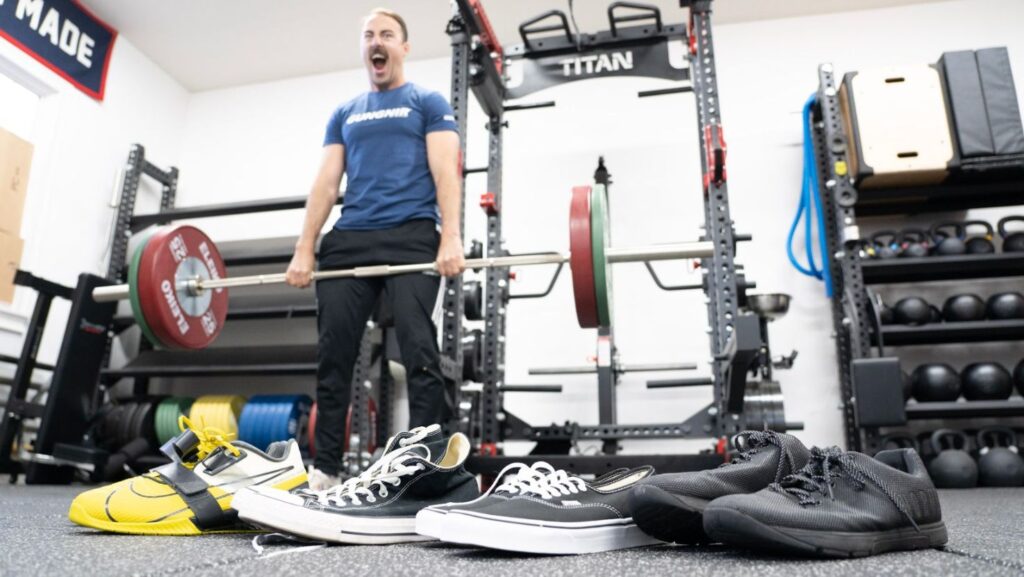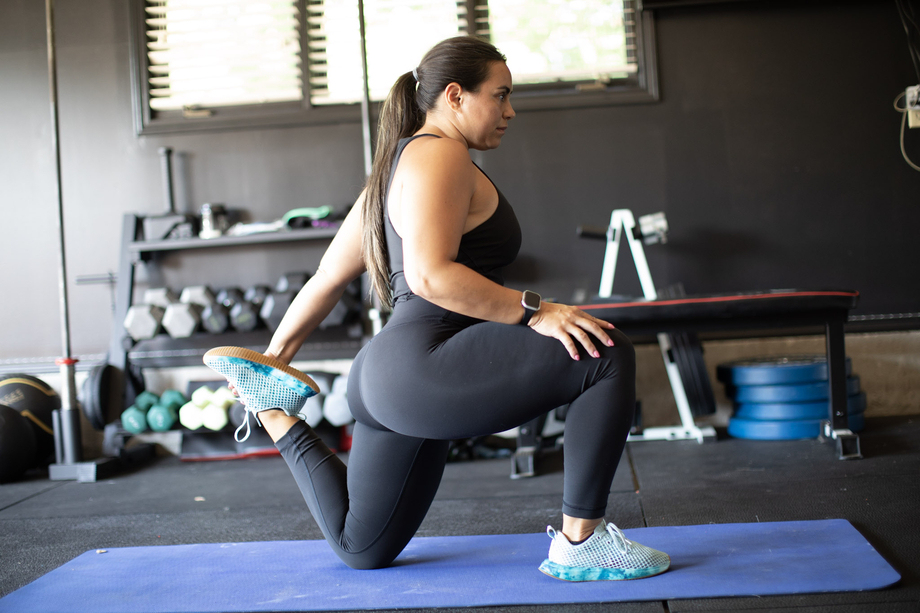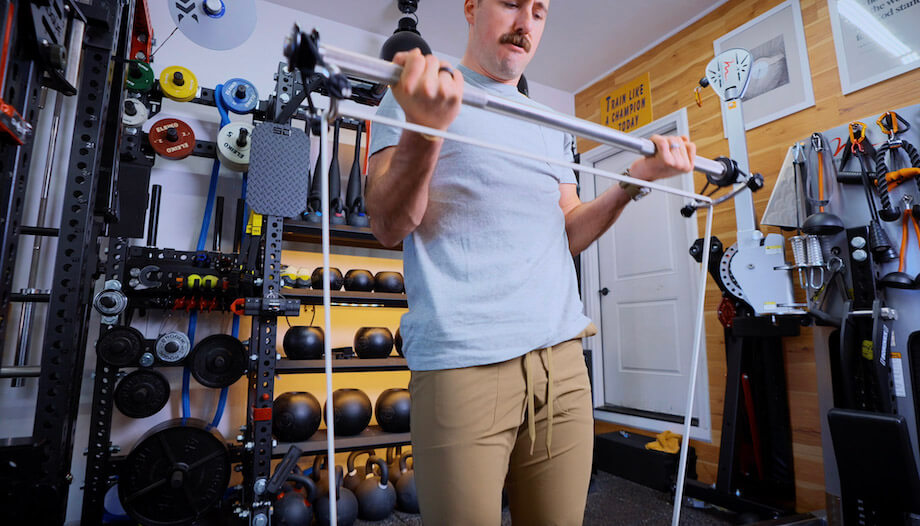We test and review fitness products based on an independent, multi-point methodology. If you use our links to purchase something, we may earn a commission. Read our disclosures.
Don’t let the name fool you. Strength training is about so much more than muscle growth. Sure, it’s one of the best ways to build muscle and get stronger, but regular resistance training (whether you rely on body weight exercises, free weights, or resistance bands) can positively affect your health in so many ways beyond that, too.
Lifting weights can improve your body composition (no, you won’t get bulky), strengthen your bones, improve balance and coordination, and keep your memory sharp. It can also decrease your risk of chronic diseases, like Type 2 diabetes and heart disease. Not to mention, it just makes you feel happier.
The bottom line? You should absolutely be incorporating strength training into your regular workout routine. If you need some science-backed convincing, read on for 12 benefits of strength training.
What Is Strength Training?
Before jumping into the health benefits of strength training, let’s back up a second and define what it is. Strength training, also referred to as resistance training, is any type of exercise that triggers your muscles to contract against some form of resistance. The resistance could be your own body weight (like in the case of push-ups, squats, lunges, or pull-ups) or an outside form of resistance, like a barbell, dumbbells, or a kettlebell.
As the name implies, these types of exercises help build muscle strength, but they do so much more than that, too. Let’s get into it.
1. Builds Muscle
We’ll start with the obvious. Strength training helps you build muscle. It stimulates a process called muscle hypertrophy, which is really just a scientific term that means your muscles are growing.
According to a report in Current Sports Medicine Reports1, inactive adults lose about 3% to 8% of their muscle mass every decade. This can contribute to a reduced metabolic rate and higher levels of body fat.
Strength training is a way to combat this. In that same report, researchers called out that in just 10 weeks of resistance training, you could potentially add about three pounds of lean muscle mass to your body, while also getting rid of four pounds of body fat. Your resting metabolic rate could also increase by about 7%, too.
2. Increases Strength
As you build muscle, you’ll also become stronger. Strength training increases your maximal force expression2 (or your ability to produce force) and time-limited force expression (or your ability to generate more force in a smaller amount of time).

Research3 shows that both high-load (heavy weights) and low-load (lighter weights) resistance training can make you stronger, but there is a caveat here: As you become more physically fit, heavier loads have a greater benefit on muscular strength. But still, any type of resistance training can increase your strength, even in those who train regularly.
3. Can Help With Fat Loss
If you’re hitting those cardio machines in the name of fat loss, stop. Well, don’t stop, but understand that adding a strength training program to your cardio routine is the most effective way to promote fat loss.
In one study published in BMC Public Health4, researchers looked at how different exercise programs—strength training only, cardio only, and a combination of both types of exercise—affected participants over a period of 12 weeks. They found that the combination group had more significant fat loss and overall weight loss. They also had greater improvements in their cardiorespiratory fitness overall.
While cardio burns more calories in the moment5 (especially if you’re doing HIIT exercises), consistent weight lifting elicits a greater overall calorie burn. Over time, strength training increases your resting metabolic rate (RMR), which is the number of calories you burn when just existing. In a study published in the European Journal of Clinical Nutrition6, researchers found that a nine-month strength training program could increase RMR by about 5%, on average.
RELATED: Strength Training for Runners
4. Strengthens Your Bones and Joints
Strength training exercises aren’t just for your muscles; they help build strong bones, too. When you hit 30 to 40, gradual bone loss7 begins. Then at the age of 708, you enter a period where bone loss starts to happen more rapidly, especially in the hips.
Weight training is highly effective for preserving bone and muscle mass9, especially in older adults. When you weight train, your muscles and tendons apply tension to your bones, which are living tissues. This stimulates the bones to produce new bone tissue, which increases bone mineral density and can reduce the risk of osteoporosis and fractures.
In a small study published in Sensors10, researchers recruited 29 postmenopausal women with osteopenia or osteoporosis. They separated them into two groups: The first group didn’t get any physical activity and the second group did six months of strength training. After the study period, researchers measured bone density and found that the strength training group had significant increases. The researchers also went on to say that keeping up the routine could likely prevent future bone loss.
5. Decreases Risk of Falling
Falls are not good for anyone, but they can be especially problematic for older adults. According to a report in the Journal of the International Academy of Neuromusculoskeletal Medicine11 (JIANM), falls are the leading cause of injuries for adults aged 65 and older. And the main causes of those falls are less strength in the lower body, instability, and lack of coordination—all things strength training can help with.
As we now already know, strength builds muscle strength, but it also improves overall body mechanics and balance12. The JIANM report says that lower body progressive resistance training (a program where the load is progressively increased as your muscle groups adapt) appears to be most effective for preventing falls.
In one study published in BMJ13, researchers put participants aged 70 or older who were prone to falls on a combo strength and balance training program. After a year of consistency, they reported improvements in balance, ankle strength, and overall function that led to a 31% reduction in fall rate.
6. Lowers Overall Injury Risk
When you have stronger bones and better balance, you automatically have a lower risk of injury, too. Better bone health translates to reduced fracture risk, while better balance means fewer falls (and the scrapes, breaks, and bruises that can come with them).
But strength training can also help reduce the risk of sports injuries in athletes. In a meta-analysis that was published in the British Journal of Sports Medicine14, researchers looked at 25 trials that included data from 26,610 participants. They found that strength training could reduce sports injuries to less than one-third, and cut the risk of overuse injuries in half.
7. Promotes Flexibility and Mobility
Stretching is often hailed as the go-to for improving flexibility and mobility, but strength training can give you similar results. In a study published in the Journal of Strength and Conditioning Research15, researchers compared static stretching to full-range resistance training on hamstring, hip, quadriceps, knee, and shoulder extension flexibility. They found that both types of exercises improved flexibility of all muscle groups to a similar degree.

Another study published in Frontiers in Physiology16 looked at eccentric strength training, which focuses on tension being applied to the muscle lengthening portion of an exercise, specifically. They found that this type of targeted resistance training could improve flexibility and strength, while also lowering the risk of injury.
While stretching and strength training are both effective on their own, combining regular strength training with stretching17 may be most effective.
8. Supports Heart Health
Aerobic exercise is widely known for improving cardiovascular health18 and reducing your risk of heart disease. When comparing the two types, aerobic exercise still comes out on top, but resistance training can help, too.
In a survey that was published in Medicine and Science in Sports and Exercise19, researchers evaluated just over 12,500 participants from different age groups. They found that adding one to three strength training sessions to your weekly workout routine could decrease the risk of cardiovascular events by 40-70%—and that was independent of any cardio exercise.
The researchers said that part of this was a direct effect; resistance training lowered cholesterol and balanced blood sugar. But it also had to do with the fact that strength training decreases your body mass index (BMI) and combats obesity, two risk factors for cardiovascular disease.
Another study published in PLoS One20 compared aerobic exercise on its own, strength training on its own, and a combo of the two on heart disease risk. Perhaps unsurprisingly, they found that doing both types of exercise had the biggest benefit. Even more interesting: Neither cardio or strength training on its own had an effect on blood pressure, but the combo program reduced numbers significantly.
9. Positively Affects Mental Health
Exercise releases endorphins—hormones that make you feel good. But that’s only part of the story. The science isn’t totally settled on exactly how resistance training boosts mood, but we just know that it does.
In a study published in Aging & Mental Health21, researchers had older women with depressive and anxiety symptoms follow a 12-week resistance training program. The program was nothing extreme: They did eight to 12 repetitions of eight whole-body exercises three days a week. At the end of the study, the researchers saw significant improvement in both depression and anxiety symptoms, regardless of age and muscular strength.
Another meta-analysis in Sports Medicine22 specifically looked at anxiety across genders and physical and mental health statuses. They found that resistance training significantly reduced anxiety symptoms, independent of any other factors.
There was also a review published in Clinical Rheumatology23 that looked at the mental health of people with fibromyalgia, which is linked to depression. After looking through 481 studies, researchers concluded that resistance training could improve mental health in this specific population, too. If you’re new to weight training, starting with low-intensity and gradually working your way up is highly effective.
10. Supports Cognitive Health
Strength training also supports brain health and cognitive function24. As you age, your cognitive abilities, like processing speed and memory, start to decline. This is largely due to structural changes in the brain.
According to a study published in the European Review of Aging and Physical Activity25, strength training can trigger positive structural changes, and slow down shrinking of brain structures associated with declines in cognitive health. This can have a positive effect on executive functions, which include memory, thinking, self-control, and goal-setting (and goal-accomplishing).
Another study26 looking at memory specifically found that regular resistance training had a positive effect on working memory, short-term memory, and immediate memory.
11. May Help Manage Blood Sugar
As of 2022, the CDC27 estimates that one in 10 Americans has diabetes, and more than one in three have pre-diabetes. And the majority of people don’t even know it.
A lack of physical activity28 is strongly correlated with Type 2 diabetes, as is a higher percentage of body fat29, even with a normal BMI. Strength training can help with both of those things, and there are studies that show it can directly help control glucose levels30 in those with Type 2 diabetes, too.
Any amount of strength training can help, especially if you’re new to weight lifting. But a report published in the International Journal of Environmental Research and Public Health31 showed that high-intensity resistance training may be more beneficial than low-to-moderate intensity resistance training specifically for this purpose.
Strength training can serve as a preventative tool, too. It improves overall metabolic health and combats metabolic risk factors, including poor blood sugar control. According to a review published in BioMed Research International32, people who spend at least 150 minutes per week strength training have a 34% reduced risk of developing diabetes. People with a BMI of over 30 who spend the same amount of time strength training have a 60% lower risk.
12. Increases Quality of Life Overall
All of the above points really culminate into one major health benefit: a better quality of life33. Aside from the direct mental health benefits, feeling strong, being confident in your body composition and having a lower risk of chronic disease and injuries just make you feel good. These things keep you active and mobile and offer more independence, especially as you age—and there’s really not much better than that.

Benefits of Strength Training: Final Thoughts
If you haven’t already, now’s the time to incorporate strength training into your routine. You might start for the strength and body composition benefits, but the sharper mind, better mood, and improved quality of life are likely what’s going to keep you going. And this can not be overstated: If you want to age healthfully, strength training is a must.
Benefits of Strength Training: Q&A
Does Strength Training Help Belly Fat?
The short answer: It depends. Strength training can help burn calories and decrease belly fat34, specifically. This is not to say that strength training targets belly fat—no exercise does—but the combination can help you change your body composition and lower your overall body fat percentage.
How Long Should A Strength Training Session Be?
Most often, a strength training session will last between 30 and 60 minutes. But there’s no real guideline on how long an individual strength training session should be. According to the CDC35, the current Physical Activity Guidelines for Americans recommends 150 minutes of moderate-intensity physical activity, with two days of strength training each week. This is inclusive of all types of workouts though, including cardio.
How Many Days A Week Is Ideal For Strength Training?
The ideal cadence depends on your fitness level. The American College of Sports Medicine36 recommends two to three days per week for novice training, three to four days per week for intermediate training, and four to five days per week for advanced training. The right amount for you depends on your goals. Work with a certified personal trainer or a qualified health professional to develop a targeted plan.
References
1. Westcott, WL. Resistance training is medicine: effects of strength training on health. Curr Sports Med Rep. 2012;11(4):209-216. doi:10.1249/JSR.0b013e31825dabb8
2. Suchomel, TJ, Nimphius, S, Bellon, CR, Stone, MH. The importance of muscular strength: training considerations. Sports Med. 2018;48(4):765-785. doi:10.1007/s40279-018-0862-z
3. Schoenfeld, BJ, Grgic, J, Van Every, DW, Plotkin, DL. Loading recommendations for muscle strength, hypertrophy, and local endurance: a re-examination of the repetition continuum. Sports (Basel). 2021;9(2):32. Published 2021 Feb 22. doi:10.3390/sports9020032
4. Ho, SS, Dhaliwal, SS, Hills, AP, Pal, S. The effect of 12 weeks of aerobic, resistance or combination exercise training on cardiovascular risk factors in the overweight and obese in a randomized trial. BMC Public Health. 2012;12:704. Published 2012 Aug 28. doi:10.1186/1471-2458-12-704
5. Falcone, PH, Tai, CY, Carson, LR, et al. Caloric expenditure of aerobic, resistance, or combined high-intensity interval training using a hydraulic resistance system in healthy men. J Strength Cond Res. 2015;29(3):779-785. doi:10.1519/JSC.0000000000000661
6. Aristizabal, JC, Freidenreich, DJ, Volk, BM, et al. Effect of resistance training on resting metabolic rate and its estimation by a dual-energy X-ray absorptiometry metabolic map. Eur J Clin Nutr. 2015;69(7):831-836. doi:10.1038/ejcn.2014.216
7. Hunter, DJ, Sambrook, PN. Bone loss. Epidemiology of bone loss. Arthritis Res. 2000;2(6):441-445. doi:10.1186/ar125
8. Berger, C, Langsetmo, L, Joseph, L, et al. Change in bone mineral density as a function of age in women and men and association with the use of antiresorptive agents. CMAJ. 2008;178(13):1660-1668. doi:10.1503/cmaj.071416
9. Hong, AR, Kim, SW. Effects of resistance exercise on bone health. Endocrinol Metab (Seoul). 2018;33(4):435-444. doi:10.3803/EnM.2018.33.4.435
10. Holubiac, IȘ, Leuciuc, FV, Crăciun, DM, Dobrescu T. Effect of strength training protocol on bone mineral density for postmenopausal women with osteopenia/osteoporosis assessed by dual-energy X-ray absorptiometry (DEXA). Sensors (Basel). 2022;22(5):1904. Published 2022 Feb 28. doi:10.3390/s22051904
11. Shaw, T, Sergent, A, Lorentz, D. Resistance training for fall prevention: a narrative review of the literature. JIAMN. 2022. 19(1):3-9.
12. Johns Hopkins Medicine. Fall prevention: balance and strength exercises for older adults.
13. Clemson, L, Fiatarone, Singh, MA, Bundy, A, et al. Integration of balance and strength training into daily life activity to reduce rate of falls in older people (the LiFE study): randomised parallel trial. BMJ. 2012;345:e4547. Published 2012 Aug 7. doi:10.1136/bmj.e4547
14. Lauersen, JB, Bertelsen, DM, Andersen, LB. The effectiveness of exercise interventions to prevent sports injuries: a systematic review and meta-analysis of randomised controlled trials. Br J Sports Med. 2014;48(11):871-877. doi:10.1136/bjsports-2013-092538
15. Morton, SK, Whitehead, JR, Brinkert, RH, Caine, DJ. Resistance training vs. static stretching: effects on flexibility and strength. J Strength Cond Res. 2011;25(12):3391-3398. doi:10.1519/JSC.0b013e31821624aa
16. Vetter, S, Schleichardt, A, Köhler, HP, Witt, M. The effects of eccentric strength training on flexibility and strength in healthy samples and laboratory settings: a systematic review. Front Physiol. 2022;13:873370. doi:10.3389/fphys.2022.873370
17. Simão, R, Lemos, A, Salles, B, et al. The influence of strength, flexibility, and simultaneous training on flexibility and strength gains. J Strength Cond Res. 2011;25(5):1333-1338. doi:10.1519/JSC.0b013e3181da85bf
18. Pinckard, K, Baskin, KK, Stanford, KI. Effects of exercise to improve cardiovascular health. Front Cardiovasc Med. 2019;6:69. doi:10.3389/fcvm.2019.00069
19. Liu, Y, Lee, DC, Li, Y, et al. Associations of resistance exercise with cardiovascular disease morbidity and mortality. Med Sci Sports Exerc. 2019;51(3):499-508. doi:10.1249/MSS.0000000000001822
20. Schroeder, EC, Franke, WD, Sharp, RL, Lee, DC. Comparative effectiveness of aerobic, resistance, and combined training on cardiovascular disease risk factors: A randomized controlled trial. PLoS One. 2019;14(1):e0210292. Published 2019 Jan 7. doi:10.1371/journal.pone.0210292
21. Cunha, PM, Werneck, AO, Nunes, JP, et al. Resistance training reduces depressive and anxiety symptoms in older women: a pilot study. Aging Ment Health. 2022;26(6):1136-1142. doi:10.1080/13607863.2021.1922603
22. Gordon, BR, McDowell, CP, Lyons, M, Herring, MP. The Effects of resistance exercise training on anxiety: a meta-analysis and meta-regression analysis of randomized controlled trials. Sports Med. 2017;47(12):2521-2532. doi:10.1007/s40279-017-0769-0
23. Vilarino, GT, Andreato, LV, de Souza, LC, Branco, JHL, Andrade, A. Effects of resistance training on the mental health of patients with fibromyalgia: a systematic review. Clin Rheumatol. 2021;40(11):4417-4425. doi:10.1007/s10067-021-05738-z
24. Landrigan, JF, Bell, T, Crowe, M, Clay, OJ, Mirman, D. Lifting cognition: a meta-analysis of effects of resistance exercise on cognition. Psychol Res. 2020;84(5):1167-1183. doi:10.1007/s00426-019-01145-x
25. Herold, F., Törpel, A., Schega, L. et al. Functional and/or structural brain changes in response to resistance exercises and resistance training lead to cognitive improvements—a systematic review. Eur Rev Aging Phys Act. 2019; 16(10). doi: 10.1186/s11556-019-0217-2
26. Wu, J, Wang, X, Ye, M, Wang, L, Zheng, G. Effect of regular resistance training on memory in older adults: A systematic review. Exp Gerontol. 2021;150:111396. doi:10.1016/j.exger.2021.111396
27. Centers for Disease Control and Prevention (CDC). The facts, stats, and impacts of diabetes. 2022.
28. Aune, D, Norat, T, Leitzmann, M, Tonstad, S, Vatten, LJ. Physical activity and the risk of type 2 diabetes: a systematic review and dose-response meta-analysis. Eur J Epidemiol. 2015;30(7):529-542. doi:10.1007/s10654-015-0056-z
29. Gómez-Ambrosi, J, Silva, C, Galofré, JC, et al. Body adiposity and type 2 diabetes: increased risk with a high body fat percentage even having a normal BMI. Obesity (Silver Spring). 2011;19(7):1439-1444. doi:10.1038/oby.2011.36
30. Pesta, DH, Goncalves, RLS, Madiraju, AK, Strasser, B, Sparks, LM. Resistance training to improve type 2 diabetes: working toward a prescription for the future. Nutr Metab (Lond). 2017;14:24. doi:10.1186/s12986-017-0173-7
31. Liu, Y, Ye, W, Chen, Q, Zhang, Y, Kuo, CH, Korivi, M. Resistance exercise intensity is correlated with attenuation of HbA1c and insulin in patients with type 2 diabetes: a systematic review and meta-analysis. Int J Environ Res Public Health. 2019;16(1):140. doi:10.3390/ijerph16010140
32. Strasser, B, Pesta, D. Resistance training for diabetes prevention and therapy: experimental findings and molecular mechanisms. Biomed Res Int. 2013;2013:805217. doi:10.1155/2013/805217
33. Borges-Silva, F, Martínez-Pascual, M, Colomer-Poveda, D, Márquez, G, Romero-Arenas, S. Does heavy-resistance training improve mobility and perception of quality of life in older women?. Biology (Basel). 2022;11(5):626. doi:10.3390/biology11050626
34. Alberga, AS, Prud’homme, D, Kenny, GP, et al. Effects of aerobic and resistance training on abdominal fat, apolipoproteins and high-sensitivity C-reactive protein in adolescents with obesity: the HEARTY randomized clinical trial. Int J Obes (Lond). 2015;39(10):1494-1500. doi:10.1038/ijo.2015.133
35. Centers for Disease Control and Prevention (CDC). How much physical activity do adults need?
36. American College of Sports Medicine. American College of Sports Medicine position stand. Progression models in resistance training for healthy adults. Med Sci Sports Exerc. 2009;41(3):687-708. doi:10.1249/MSS.0b013e3181915670
Further reading

Heading into 2024, we take a look at home gym equipment trends based on search trend data, to see how strength and cardio have fared over the past decade. Read more

The Reverse Hyper is one of the most coveted pieces of equipment in any gym. In this Do-It-Yourself Tutorial, we'll show you how to make your own DIY Reverse Hyper Machine for less than $100. Read more

We’ll go over key features and upgrades in this first look at the soon-to-be-released cross-training shoe. Find out more in this Reebok Nano X5 review. Read more

The PRx Performance Profile Pro Squat Rack is the best space saving squat rack currently available. We've used and tested many of the various options including the popular fold-away racks and undoubtedly, the Profile Squat Racks from PRx Performance are not only extremely sturdy, but also the most convenient. Read more

